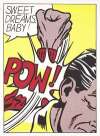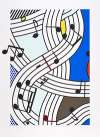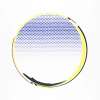A Seller’s Guide To Roy Lichtenstein


Interested in buying or selling
Roy Lichtenstein?
Market Reports
Roy Lichtenstein, a leading voice in the Pop Art movement, embraced printmaking for its ability to mirror the clean precision of industrial production. As he put it, “I wanted my prints to be very simple and mechanical... In the prints, you can achieve that sense of perfection.” This Seller’s Guide offers practical insight to help you time your sale effectively and achieve the best possible outcome.
Is Now A Good Time To Sell A Roy Lichtenstein Print?
Lichtenstein’s print market is experiencing a strong moment in 2025 – driven by a combination of rising auction values, standout results for key series, and continued institutional attention. For collectors considering a sale, these aligned signals present a timely opportunity to capitalise on current demand while the market remains active and liquid.
Strong Performance in 2025 – Capped by a Landmark Sotheby's Sale
Lichtenstein’s print market has been on strong footing throughout 2025, with auction value climbing even as total lot volume slightly declined year-on-year. That momentum was capped in September by a headline-making single-owner sale at Sotheby’s, which delivered a white glove result: over 90 works offered, every lot sold, and multiple new auction records set across subject, medium, and era.
Prominent records included:
Thinking Nude (State I) – $508,000
Reverie – $355,600
Forms in Space – $317,500
Sweet Dreams Baby! – $190,500
Water Lilies – Blue Lily Pads – $228,600
The Oval Office – $228,600
While strong provenance from the artist’s estate undoubtedly contributed, the breadth of record-breaking results – spanning Pop icons, late-career works, political portraits, and rare proofs – confirmed Lichtenstein’s broad and resilient appeal.
Importantly for sellers, this wasn’t just a one-off success. The sale validated the market trajectory seen earlier in the year, from standout results like Roommates (£419,100 in March) to strong demand for artist’s proofs and conceptual works. With a Whitney Museum retrospective scheduled for 2026 and institutional visibility still high, the current moment offers favourable selling conditions – especially for rare, well-preserved, or highly recognisable works.
Lichtenstein Nudes Series Price Growth in 2025
One of the most telling indicators of Lichtenstein’s market momentum is the ongoing strength of his Nudes series. Average values for these works have climbed from £162,000 in 2022 to £329,000 in 2024. Even with a modest correction to £288,000 in 2025, prices remain well above pre-2023 levels -evidence of a broader revaluation of this late-career series. Read our dedicated Nudes Market Report.
Sotheby's Presents The Dorothy and Roy Lichtenstein Collection
This demand was underscored by Sotheby’s May 2025 sale of over 40 works from the Dorothy and Roy Lichtenstein Collection, including several rare Nudes prints. With all lots carrying guarantees, most exceeded their high estimates, and several set new records – building on momentum first seen in November 2024.
While strong provenance from the artist’s estate clearly played a role, these sales brought renewed attention to Lichtenstein’s market. However, following two high-profile estate releases, it wouldn’t be surprising to see the market enter a more selective phase. For sellers, this could represent a smart time to consider private placements – helping to avoid auction fatigue while demand remains high and supply limited.
Selling Lichtenstein Prints During Peak Market Visibility and Exhibitions
Broader visibility also plays a part in pricing dynamics. Since the Roy Lichtenstein Foundation’s 2023 global gifting initiative, interest in the artist has been steadily building. His centennial year in 2024 was marked by widespread press and a flagship retrospective at the Albertina Museum in Vienna, contributing to a 23% increase in global auction sales. Download our latest Roy Lichtenstein market report to explore price growth and global trends in his market.
Momentum continues into 2026. Pop Art and Fashion opens at Les Abattoirs in Toulouse in December 2025, followed by a full retrospective at the Whitney Museum in Fall 2026 – keeping Lichtenstein in the spotlight well into next year.
What This Means for Sellers
While media attention and institutional exhibitions don’t guarantee higher prices, they can create more favourable selling conditions by increasing visibility and market confidence. Some sellers may consider private transactions as a way to avoid auction saturation, protect pricing, and maintain control.
Timing is not just about headlines – it’s about aligning visibility with liquidity, provenance, and strategic placement.
Thinking of selling your Lichtenstein print?
Request a free valuation from our specialists and explore real-time demand on our Trading Floor.
What Drives Demand for Roy Lichtenstein Prints?
Benday Dots, Women, and Text
Collectors typically place a premium on unique works, but the May 2025 sales offered a different kind of signal. Despite various original drawings on offer from the Lichtenstein estate, it was the editioned prints - particularly from the Nudes and Reflections series - that drove the most competitive bidding.
Works that incorporate text are often the highest valued – reinforcing Lichtenstein’s comic-book aesthetic. This includes both his complex enamel-on-steel editions like Vicki! I Thought I Heard Your Voice, and more accessible prints like The Melody Haunts My Reverie, which just hit a new record of $355,600 (USD).
How Much Is My Roy Lichtenstein Print Worth?
Lichtenstein’s market favours high-value individual works and technically complex mediums like enamel-on-steel, rather than complete sets. Enamel editions dominate the top end of his market, particularly Girl in Mirror, Crying Girl, and Vicki!. Other standout prints include Water Lily Pond with Reflections, which has approached £1 million in recent public sales.
The chart above illustrates the market share of Lichtenstein editions by medium. Porcelain editions (enamel-on-steel) account for all the standout peaks, especially in 2015, 2019, and 2023. These surges align with the appearance of rare 1960s “girl” works, underscoring their rare public market appearances and premium value.
The Value of Artist’s Proofs and Printer’s Proofs in Lichtenstein's Market
The growing presence of special editioned proofs – particularly artist’s proofs (APs) and printer’s proofs (PPs) – has become increasingly notable. These often outperform expectations due to rarity.
This was especially evident in Sotheby’s 2025 sales, where many APs from the artist’s personal collection achieved standout prices. A similar pattern was seen in March 2025, when APs from the Bull Profile series set new records across the board.
How To Prove Your Roy Lichtenstein Print Is Real
The Roy Lichtenstein Foundation
The Roy Lichtenstein Foundation, established in 1998, was instrumental in authenticating his works until 2011, when it issued Certificates of Authenticity (COAs). However, like many artist foundations, it discontinued this service due to the overwhelming volume of requests and the legal complexities surrounding authentication. Today, the Foundation’s primary focus is on research, scholarship, and preserving Lichtenstein’s artistic legacy.
Roy Lichtenstein Catalogue Raisonné
One of the most important tools for verifying Lichtenstein prints is the catalogue raisonné. The Prints of Roy Lichtenstein: A Catalogue Raisonné 1948–1993, compiled by Mary Lee Corlett and published in 2002, offers detailed listings, provenance, and images for all known editions, and remains a key reference for collectors and sellers. To support ongoing research, the Foundation has also made the catalogue available online, alongside a digital archive of over 5,000 works. For anyone selling a Lichtenstein print, referencing the catalogue is essential for confirming authenticity and provenance.
Publications and Documentation
Lichtenstein collaborated with leading print publishers such as Gemini G.E.L., Tyler Graphics, and the Leo Castelli Gallery - each playing a key role in documentation and authentication. Publishers like Gemini G.E.L. typically included blindstamps and ink stamps either on the front or reverse of prints, which should correspond to the details listed in the catalogue raisonné.
Works produced by the Leo Castelli Gallery - Lichtenstein’s exclusive dealer in the 1960s - present added complexity. Castelli occasionally issued signed but unnumbered editions, such as Crying Girl and Shipboard Girl, which are more accessible on the market but require expert verification due to their uncertain edition size. According to Pop Art expert Richard Polsky, Castelli also sold unsigned exhibition posters, whcih can still hold value; however, authenticating them requires close examination of paper type and the printing techniques used at the time.
Documentation such as the signature, edition number, and date is essential for authentication, especially given the history of forged markings. Lichtenstein generally signed, numbered, and dated his prints in the lower right margin, but this can vary from print to print.
Looking To Sell Your Lichtenstein Print?
Explore Lichtenstein Prints on the Trading Floor and contact us for a complimentary, no-obligation valuation.
How To Care For Your Roy Lichtenstein Print
The condition of Lichtenstein prints play a critical role in preserving their market value. Whether printed on Arches wove, Rives BFK, or Japanese Kitakata paper, proper care is essential to prevent damage and maintain long-term integrity.
Storage & Display Best Practices
To protect your print, avoid exposure to direct light, humidity, and improper handling. When displaying, always use UV-protective glazing and keep the work out of sunlight to prevent fading. For storage, lay the print flat in a dark, temperature-controlled space, ensuring it’s not crowded or at risk of creasing or warping.
Never Trim the Margins
One of the most common mistakes among new collectors is trimming a print to fit a frame. Any alteration - especially to the margins - can be easily detected at resale and will significantly reduce the work’s value. This applies even to Lichtenstein posters, which, despite being mass-produced, retain collector interest when kept in original condition.
Paper Aging & Condition Issues
Lichtenstein’s prints, particularly those on Arches or Rives BFK, can be prone to darkening, foxing, or staining over time. Tears, discolouration, and other signs of deterioration can have a significant impact on value. If any issues arise, it’s essential to consult a professional conservator rather than attempt repairs yourself, as improper restoration can cause permanent damage.
Best practices on caring for prints and editions were recently explored in MyArtBroker’s OPEN EDITION live panel, Preserving Value. If you’re unsure about the condition or authenticity of your print, it is always recommend consulting a professional. Visit The Directory for a curated list of trusted framers and conservators in the art trade.
Ways to Sell with MyArtBroker
At MyArtBroker, our specialists offer free market valuations backed by a level of transparency rarely seen in today’s art market. Through our online Trading Floor, sellers gain real-time insights into demand for specific works by the artist - what’s wanted, what’s for sale, and what’s moving - helping you trust the valuation you receive.
Our approach is tailored to align with the unique attributes of each artwork, and offer optimal results:
How a Private Sale Works
Unlike peer-to-peer platforms, which often lack specialist expertise, authentication guarantees, and the legal infrastructure needed for high-value sales, MyArtBroker facilitates secure private transactions with full support at every stage. We charge sellers 0%, taking a small commission from buyers, which covers insurance, shipping, and marketing - at no extra cost to the seller.
Our business model is intentionally streamlined, allowing us to offer greater value and stronger returns than traditional sales channels. Revenue is generated solely from buyer commissions, negotiated individually at the point of offer, ensuring our incentives are aligned with delivering the best outcome for our clients.
We focus on artworks valued over £10,000, providing tailored care and market expertise to maximise each sale. For works below that threshold, our team offers free, personalised advice to help you find the right route to market. At MyArtBroker, we provide a specialist-led, seamless alternative in today’s evolving art landscape.
Advisory and Recommendations
For works that may fall outside our core collector network - due to value, medium, or condition - we collaborate with trusted partners to ensure the right placement. This tailored approach considers the unique attributes of each piece and is designed to achieve the best outcome in today’s evolving market. You can explore this strategy with us at no cost as part of our advisory service.
Recommendations are made on a case-by-case basis, drawing on our knowledge of where a work is most likely to succeed and ensuring it reaches the right audience.
Why Sell Your Roy Lichtenstein Print With MyArtBroker
A Dedicated Expert
Selling your Lichtenstein print with MyArtBroker means working with a dedicated specialist who understands both your goals and the nuances of the market. We offer complimentary, no-obligation valuations, backed by deep expertise in Lichtenstein’s work, to give you an accurate and informed view of your print’s current value.
Minimise Risk
Transparency and security are central to our process. Our live Trading Floor provides real-time market insights, while our due diligence process ensures authenticity and provenance - minimising the risks of forgery or misrepresentation. Unlike public auctions, which can leave works unsold and affect market perception, we offer private sales that provide more control, quicker liquidity, and protection from market volatility.
0% Seller’s Fees, 100% of the Time
We never charge seller’s fees - allowing you to retain 100% of the sale price. Our model outperforms traditional auctions by combining specialist insight with targeted marketing across our platform, network, and in-house magazine. We focus on main editions and rare and special edition prints, offering a seamless experience for both new and seasoned collectors.
Extensive Network
With a network of over 30,000 collectors actively buying and selling, we can connect your Lichtenstein print with the right buyer - quickly and strategically - maximising your chances of a successful sale.
Roy Lichtenstein Collection Management with MyPortfolio
As the art world increasingly shifts toward data-driven infrastructure, platforms like MyPortfolio are reshaping how collectors manage and assess value. MyArtBroker’s free collection management tool offers Lichtenstein collectors real-time insight into their holdings - drawing on over 50,000 global auction records and powered by our proprietary algorithm, SingularityX, which considers condition, colourway, rarity, and other value-driving variables.
As noted in the May 2025 Market Editor Report, the biggest story of the moment isn’t just about what’s selling -but how decisions are being made. With the rise of algorithmic pricing tools, institutional consolidation, and acquisitions like Beowolff Capital’s purchase of Artnet, the market is becoming more centralised -and the players with the most robust data are shaping the rules. Platforms are no longer just about access -they’re about analysis, visibility, and control.
MyPortfolio is ahead of the curve. It offers collectors transparent access to auction histories, pricing trends, and current demand - data that is often gated or costly elsewhere. Whether you’re preparing to sell a Lichtenstein print or simply monitoring its market trajectory, MyPortfolio puts powerful decision-making tools at your fingertips, allowing you to navigate a changing art economy with clarity and confidence.













